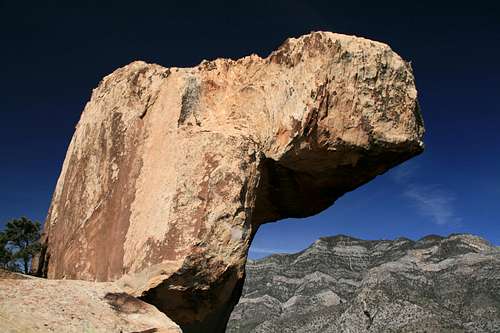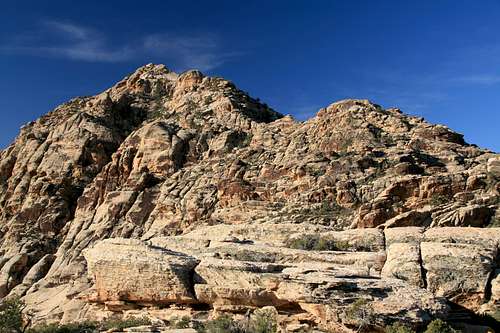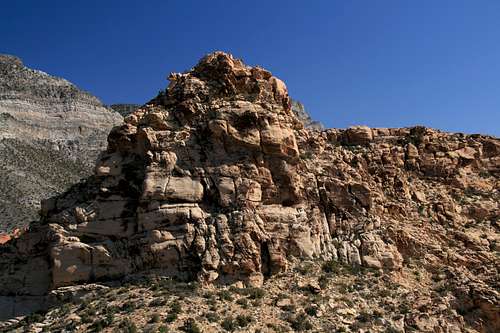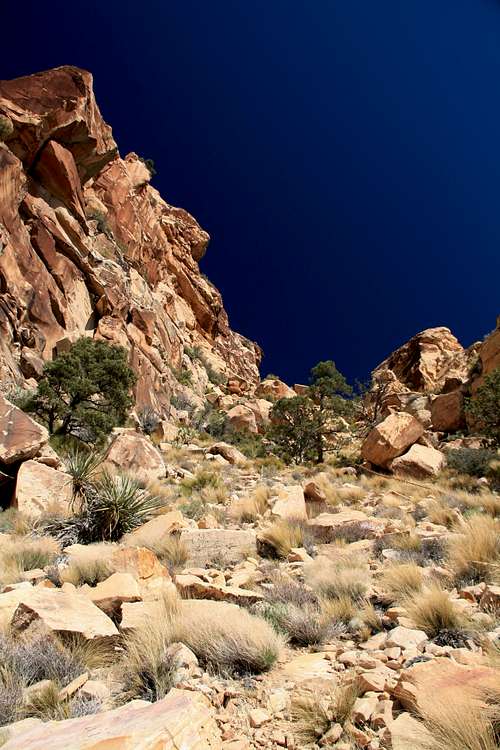-
 4589 Hits
4589 Hits
-
 79.04% Score
79.04% Score
-
 10 Votes
10 Votes
|
|
Route |
|---|---|
|
|
36.17924°N / 115.48974°W |
|
|
Scrambling |
|
|
Spring, Fall, Winter |
|
|
Class 3-4 |
|
|
Overview
This outing covers the route on White Rock Peak that Courtney Purcell describes in Rambles & Scrambles: The Definitive Guide to Peakbagging Around Las Vegas and then a traverse from that summit to that of White Rock Spring Peak. It is a loop-style outing that begins and ends at the end of the dirt road to the White Rock Spring trailhead. Although the route does not need to be harder than Class 3, you should expect Class 4 conditions here and there, and harder than that is easily found. Route-finding is not difficult but is just challenging enough to keep things interesting, especially on the way to White Rock Peak.The route is 5-6 miles in all, with about 2000' of elevation gain.
It is best to climb White Rock Peak first and then traverse to White Rock Spring Peak because you will have ample opportunities to scout out the best route to the latter along the way. That best way will be a little harder to discern if going from White Rock Springs Peak, especially since the peak ends in an imposing cliff that may lead one to think there is no safe way to traverse to White Rock Peak.
Getting There
From Charleston Boulevard (Route 159) west of I-215 and Summerlin, turn onto the Scenic Drive in RRCNCA and drive 6 miles to the turnoff for White Rock Spring. Follow the rocky road for a half-mile to the parking area and trailhead. Note that in 2012, there was a $7 daily fee to enter the Scenic Drive.Route Description
From the trailhead, you can see an obvious saddle between the two peaks (White Rock Peak is on the left and White Rock Spring Peak is on the right). This is your first destination. Hike the short, easy trail to White Rock Spring and then either drop into the wash and gully leading to the saddle or make a sidehilling traverse to gain them higher up. Purcell mentions tedious brush on the approach, but I did not find it to be too bad, though I used the traverse approach and the drainage itself did look brushier.From the saddle, follow the ridge up to the summit of White Rock Peak. The going is mostly intuitive, but cairns are present much of the way as well though mostly unnecessary. If you get into Class 5 terrain, retreat and look for something easier. There are occasionally exposed spots, but overall, there is little exposure on the route. The summit is small but not exposed.
From the summit, work your way back to the saddle. Then approach White Rock Spring Peak, crossing over some large outcrops or bypassing them on the right (the latter will mean giving up some elevation to be regained soon).
Now breathe a sigh of relief (or regret) as you realize you do not need to climb the massive cliff below the summit of White Rock Spring Peak. Instead, stay right and then find Class 2+ slopes leading up to the summit ridge. Frankly, I was disappointed not to find it more challenging, as I had heard it could be a hairy traverse. In any event, once on the summit ridge, head left for the final easy scramble to the summit.
Instead of traversing to the right of the cliffs, one can also traverse left according to this map. I do not know if that way is easier or harder than the one described here.
Leaving the summit, follow the ridge southeast back to the parking area.





